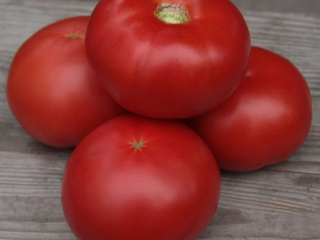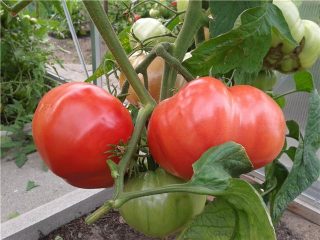Content
There are varieties of tomatoes that are reliable in cultivation and practically do not fail in yield. Each summer resident collects his own proven collection. The Red Arrow tomato variety, according to reviews from summer residents, is characterized by high yield and resistance to disease. Therefore, it is very popular and in demand among gardeners and gardeners.
Description of the variety
The Red Arrow F1 variety is of hybrid origin and belongs to the semi-determinate types. This is an early ripening tomato (95-110 days from seed germination to the first harvest). The foliage of the bushes is weak. The stems grow approximately 1.2 m tall in a greenhouse and slightly shorter when grown outdoors. On each Red Arrow tomato bush, 10-12 bunches are formed. 7-9 fruits are tied on the brush (photo).
Tomatoes have an oval-round shape, smooth skin and a dense structure. A ripe Red Arrow tomato weighs 70-100 grams. Tomatoes have a pleasant taste and, according to reviews from summer residents, are excellent for canning or eating fresh. Tomatoes are perfectly preserved and transported over long distances; the fruits do not crack and retain a pleasant presentation.
Advantages of the variety:
- resistance to adverse weather conditions;
- early yield;
- bushes tolerate a lack of light (therefore they can be placed more densely) and temperature changes;
- The Red Arrow variety is immune to many diseases (cladosporiosis, macrosporiosis, fusarium, tobacco mosaic virus).
The variety has not yet shown any particular disadvantages. A distinctive feature of the Red Arrow variety of tomatoes is that the fruits can remain on the bush for up to a month. 3.5-4 kg of ripe tomatoes can easily be harvested from one plant. From a square meter of bed you can remove approximately 27 kg of fruit.
The Red Arrow tomato variety has proven itself well in risky farming areas (Middle Urals, Siberia). The variety also grows well and bears fruit in the European part of Russia.
Planting seeds
The optimal time for planting seedlings is the second half of March (approximately 56-60 days before planting seedlings in open ground). The soil mixture is prepared in advance or suitable ready-made soil is selected in the store. A drainage layer is first poured into the box (you can put expanded clay, small pebbles) and then covered with soil on top.
Stages of growing seedlings:
- Seed material is usually checked and disinfected by the manufacturer. Therefore, you can simply keep Red Arrow F 1 tomato seeds in a damp fabric bag for a couple of days for germination.
- To harden the grains, they are placed in the refrigerator for about 18-19 hours, and then heated near the radiator for about 5 hours.
- In the moistened soil, make grooves about a centimeter deep. The seeds are sprinkled with soil and slightly moistened. The container is covered with film or glass. As soon as the first shoots appear, you can open the box and place it in a lighted place.
- When two leaves appear on the seedlings, the sprouts are planted in separate containers.You can choose peat pots or use plastic cups (recommended capacity - 0.5 l). 9-10 days after transplanting the plants, fertilizer is applied to the soil for the first time. You can use solutions of both organic and inorganic fertilizers.
A week and a half before planting tomatoes in open ground, it is recommended to begin hardening the sprouts. To do this, the cups are taken out into the open air and left for a short time (an hour and a half). Gradually the hardening period is increased. Thanks to gradual adaptation to low temperatures, seedlings acquire resistance to new conditions and become stronger.
Tomato care
Red Arrow tomato seedlings at the age of 60-65 days already have 5-7 leaves. Such seedlings can be planted in a greenhouse in mid-May, and in open ground in early June.
In one row, tomato bushes are placed at a distance of approximately 50-60 cm from each other. The row spacing is made 80-90 cm wide. Ideal places for planting Red Arrow tomatoes are areas that are well heated, illuminated and protected from the winds. In order for the seedlings to grow quickly and not get sick, they should be planted after pumpkin, cabbage, carrots, beets or onions.
How to water tomatoes
The frequency of watering is determined by the rate of drying of the soil. It is believed that one watering per week is enough for the normal development of tomato bushes of this variety. But severe drought should not be allowed, otherwise the tomatoes will be small or even fall off. During fruit ripening, the volume of water is increased.
When watering, do not direct streams of water at the leaves or stems, otherwise the plant may develop late blight.If tomatoes of the Red Arrow variety are grown indoors, then after watering the greenhouse is opened for ventilation. In general, it is advisable to organize drip irrigation in a greenhouse - this way, an optimal level of humidity will be maintained and water will be saved.
After watering, it is recommended to weed the ground and cover the surface with mulch. Thanks to this, the soil will retain moisture longer. For mulching, cut grass and straw are used.
Feeding rules
Tomatoes need feeding at any period of development and growth. There are several main stages of fertilization.
- The first time fertilizer is applied one and a half to two weeks after planting the seedlings on the site. A solution of mineral fertilizers is used: 50-60 g of superphosphate, 30-50 g of urea, 30-40 g of ammonium sulfate, 20-25 g of potassium salt are diluted in a bucket of water. You can add about 100 g of wood ash. Approximately 0.5 liters of mineral solution is poured under each bush.
- Three weeks later, another portion of fertilizer is applied. 80 g of double superphosphate, 3 g of urea, 50 g of potassium salt and 300 g of wood ash are dissolved in 10 liters of water. To prevent the solution from damaging the roots or stem, make a hole around the tomato at a distance of about 15 cm from the stem, where the fertilizer is poured.
- During fruiting, lovers of early harvests add nitrophoska or superphosphate with sodium humate to the soil. Proponents of organic fertilizers use a solution of wood ash, iodine, and manganese. To do this, pour 2 liters of ash into 5 liters of boiling water. After cooling, add another 5 liters of water, a bottle of iodine, and 10 g of boric acid. The solution is infused for a day. For irrigation, the infusion is additionally diluted with water (in a ratio of 1:10). A liter is poured under each bush. You can also combine the use of organic and inorganic additives.Add 1-2 tbsp to a regular mullein solution. l drugs Kemir/Rastovrin or other stimulators of fruit formation.
The best option is to apply fertilizers when watering plants. To choose the right fertilizer, you need to observe the appearance of tomatoes of the Red Arrow F 1 variety. With increased growth of green mass, reduce the dose of nitrogen fertilizers. Yellowing of the leaves indicates an excess of phosphorus, and the appearance of a purple tint on the underside of the leaves indicates a lack of phosphorus.
To speed up the formation of ovaries and fruit ripening, foliar feeding of tomatoes is practiced. Diluted superphosphate is used as a mineral solution.
Disease and pest control
This tomato variety is highly resistant to many diseases. To prevent late blight infection, it is recommended to carry out preventive work. To do this, in the fall, the remaining leaves are carefully removed from the greenhouse. The top layer of soil (11-14 cm) is removed and fresh soil is refilled. It is best to use soil taken from the beds after beans, peas, beans, carrots or cabbage.
In the spring, before planting seedlings, the soil surface is treated with a manganese solution (blurred pink). It is advisable to spray plants with a solution of Fitosporin. This should be done in the evening so that the tomatoes are not damaged by sunlight.
Tomato Red Arrow F 1 is very popular among experienced and novice gardeners. Thanks to a lot of advantages and virtually no disadvantages, this variety is increasingly found in summer cottages.













Irina! I have a natural question for you. Take a look at the State Register, which includes VARIETIES of vegetables. Most varieties are marked F1 in the “category” column. Therefore, there is no need to state so categorically that a hybrid is not a variety. The only difference between a hybrid and a variety is that the plants do not retain their characteristics during subsequent cultivation. Hybrid seeds must be purchased annually. That's the whole difference.
Hello. Sometimes in the descriptions they actually write “grade... F1”. In order not to change the name, we write the name as assigned by the breeders. But at the same time, a hybrid is also a certain variety, just with different characteristics. For example, there are chickens that produce eggs and hatch chicks. But broiler chickens will not produce offspring.They are bred ONLY for a ONE TIME production of meat products. That is, in fact, they remain chickens.
F1 is a hybrid, not a variety. Provide the information correctly.